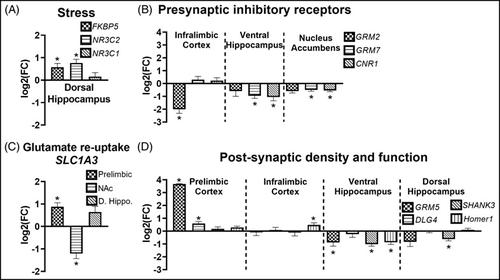当前位置:
X-MOL 学术
›
Genes Brain Behav.
›
论文详情
Our official English website, www.x-mol.net, welcomes your
feedback! (Note: you will need to create a separate account there.)
Exposure to the predator odor TMT induces early and late differential gene expression related to stress and excitatory synaptic function throughout the brain in male rats.
Genes, Brain and Behavior ( IF 2.4 ) Pub Date : 2020-07-14 , DOI: 10.1111/gbb.12684 Ryan E Tyler 1, 2 , Benjamin Z S Weinberg 2 , Dennis F Lovelock 2 , Laura C Ornelas 2 , Joyce Besheer 1, 2, 3
Genes, Brain and Behavior ( IF 2.4 ) Pub Date : 2020-07-14 , DOI: 10.1111/gbb.12684 Ryan E Tyler 1, 2 , Benjamin Z S Weinberg 2 , Dennis F Lovelock 2 , Laura C Ornelas 2 , Joyce Besheer 1, 2, 3
Affiliation

|
Persistent changes in brain stress and glutamatergic function are associated with post‐traumatic stress disorder (PTSD). Rodent exposure to the predator odor trimethylthiazoline (TMT) is an innate stressor that produces lasting behavioral consequences relevant to PTSD. As such, the goal of the present study was to assess early (6 hours and 2 days—Experiment 1) and late (4 weeks—Experiment 2) changes to gene expression (RT‐PCR) related to stress and excitatory function following TMT exposure in male, Long‐Evans rats. During TMT exposure, rats engaged in stress reactive behaviors, including digging and immobility. Further, the TMT group displayed enhanced exploration and mobility in the TMT‐paired context 1 week after exposure, suggesting a lasting contextual reactivity. Gene expression analyses revealed upregulated FKBP5 6 hours post‐TMT in the hypothalamus and dorsal hippocampus. Two days after TMT, GRM3 was downregulated in the prelimbic cortex and dorsal hippocampus, but upregulated in the nucleus accumbens. This may reflect an early stress response (FKBP5) that resulted in later glutamatergic adaptation (GRM3). Finally, another experiment 4 weeks after TMT exposure showed several differentially expressed genes known to mediate excitatory tripartite synaptic function in the prelimbic cortex (GRM5, DLG4 and SLC1A3 upregulated), infralimbic cortex (GRM2 downregulated, Homer1 upregulated), nucleus accumbens (GRM7 and SLC1A3 downregulated), dorsal hippocampus (FKBP5 and NR3C2 upregulated, SHANK3 downregulated) and ventral hippocampus (CNR1, GRM7, GRM5, SHANK3 and Homer1 downregulated). These data show that TMT exposure induces stress and excitatory molecular adaptations, which could help us understand the persistent glutamatergic dysfunction observed in PTSD.
中文翻译:

暴露于捕食者气味 TMT 会在雄性大鼠的整个大脑中诱导与压力和兴奋性突触功能相关的早期和晚期差异基因表达。
脑压力和谷氨酸能功能的持续变化与创伤后应激障碍 (PTSD) 相关。啮齿动物暴露于捕食者气味三甲基噻唑啉 (TMT) 是一种先天压力源,会产生与 PTSD 相关的持久行为后果。因此,本研究的目标是评估早期(6 小时和 2 天——实验 1)和晚期(4 周——实验 2)与 TMT 暴露后压力和兴奋功能相关的基因表达 (RT-PCR) 变化在雄性 Long-Evans 大鼠中。在 TMT 暴露期间,大鼠会出现应激反应行为,包括挖掘和不动。此外,TMT 组在暴露后 1 周在 TMT 配对环境中表现出增强的探索和移动性,表明持续的环境反应性。基因表达分析显示FKBP5上调下丘脑和海马背侧 TMT 后 6 小时。TMT 两天后,GRM3在前缘皮层和背海马中下调,但在伏隔核中上调。这可能反映了导致后期谷氨酸能适应 ( GRM3 )的早期应激反应 ( FKBP5 )。最后,TMT 暴露 4 周后的另一项实验显示了几个差异表达的基因,这些基因已知在前缘皮层(GRM5、DLG4和SLC1A3上调)、下缘皮层(GRM2下调,Homer1上调)、伏隔核(GRM7和SLC1A3下调),背侧海马(FKBP5和NR3C2上调,SHANK3下调)和腹侧海马(CNR1,GRM7,GRM5,SHANK3和HOMER1下调)。这些数据表明,TMT 暴露会诱导压力和兴奋性分子适应,这可以帮助我们了解在 PTSD 中观察到的持续性谷氨酸能功能障碍。
更新日期:2020-07-14
中文翻译:

暴露于捕食者气味 TMT 会在雄性大鼠的整个大脑中诱导与压力和兴奋性突触功能相关的早期和晚期差异基因表达。
脑压力和谷氨酸能功能的持续变化与创伤后应激障碍 (PTSD) 相关。啮齿动物暴露于捕食者气味三甲基噻唑啉 (TMT) 是一种先天压力源,会产生与 PTSD 相关的持久行为后果。因此,本研究的目标是评估早期(6 小时和 2 天——实验 1)和晚期(4 周——实验 2)与 TMT 暴露后压力和兴奋功能相关的基因表达 (RT-PCR) 变化在雄性 Long-Evans 大鼠中。在 TMT 暴露期间,大鼠会出现应激反应行为,包括挖掘和不动。此外,TMT 组在暴露后 1 周在 TMT 配对环境中表现出增强的探索和移动性,表明持续的环境反应性。基因表达分析显示FKBP5上调下丘脑和海马背侧 TMT 后 6 小时。TMT 两天后,GRM3在前缘皮层和背海马中下调,但在伏隔核中上调。这可能反映了导致后期谷氨酸能适应 ( GRM3 )的早期应激反应 ( FKBP5 )。最后,TMT 暴露 4 周后的另一项实验显示了几个差异表达的基因,这些基因已知在前缘皮层(GRM5、DLG4和SLC1A3上调)、下缘皮层(GRM2下调,Homer1上调)、伏隔核(GRM7和SLC1A3下调),背侧海马(FKBP5和NR3C2上调,SHANK3下调)和腹侧海马(CNR1,GRM7,GRM5,SHANK3和HOMER1下调)。这些数据表明,TMT 暴露会诱导压力和兴奋性分子适应,这可以帮助我们了解在 PTSD 中观察到的持续性谷氨酸能功能障碍。










































 京公网安备 11010802027423号
京公网安备 11010802027423号